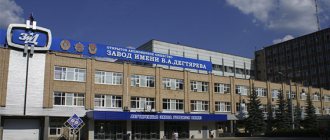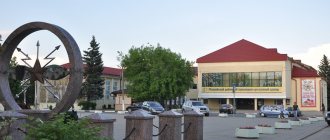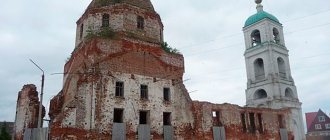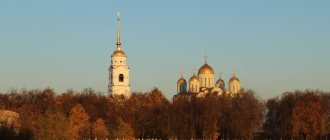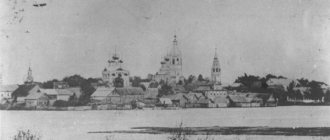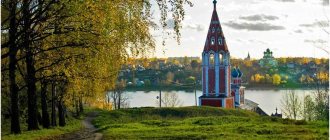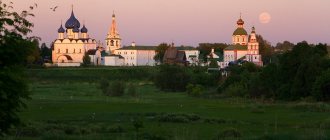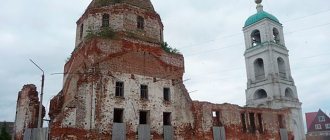Getting to know the history of the city
Belgorod - “white city”. There are 2 similar versions of why it was called that:
- In the 17th century, the fortification was erected from white stone.
- The city was built on a chalk mountain - Belaya.
And there is fierce debate among historians about the date of the city’s founding. One of the points of view is the beginning of the construction of a defensive fortress on the site of the Seversky settlement (settlement of the Eastern Slavs) in 1596. Tsar Fyodor Ioannovich ordered its construction on the mountain on the right side of the Seversky Donets River. But she didn't last long.
This place was located at the intersection of modern Kalinin and Studencheskaya streets.
The site for the construction of the second fortress was the left bank. Now this area is called the Old Town. Since 1650, the main part of Belgorod was again located on the right bank. Since 1727, it became the center of the Belgorod province, and 52 years later - a district town of the Kursk province.
The city survived attacks by the Crimean khans, Polish-Lithuanian feudal lords, and an assault on the fortress by Zaporozhye Cossacks led by Yakov Ostryanin. The buildings had to be rebuilt. After the advent of Soviet power, it was part of Ukraine for some time and even served as its temporary capital. Later it was annexed to the White South, a territory controlled by the White Guard Volunteer Army.
Archaeological research carried out in Soviet times allowed Academician Rybakov to conclude that the settlement appeared in the 10th century. In 1995, after the government adopted a resolution, Belgorod residents celebrated the 1000th anniversary of the city.
During the fighting and occupation (October 24, 1941 - August 5, 1943), not a single intact building remained in the city. The Nazis practically exterminated the indigenous inhabitants by shooting them in the park, tormenting them at the Gestapo, and burning them in a reed factory.
What to see in the vicinity of Belgorod
On the third day of your stay in Belgorod, we invite you to visit the outskirts of the city. You can go to the Prokhorovskoye Field Museum-Reserve, which is the most famous attraction located near Belgorod. Among the historical places, the Yusupov Palace Complex in Rakitnoye, the Krapivenskoe ancient settlement and the Barkov Mill stand out.
Natural attractions are the Belogorye Nature Reserve and Klyuchi Park. You can also go to the Kholkovsky Monastery, look at the Lebedinsky Quarry and take part in the Belogorie Sky Festival.
Museum-Reserve "Prokhorovskoye Field"
Museum-Reserve "Prokhorovskoye Field"
The Prokhorovskoe Field Museum-Reserve is located 60 km from Belgorod. In 1943, during the Great Patriotic War, one of the largest tank battles in the entire military history took place here.
The main monument of the memorial complex is a 59-meter belfry, consisting of 4 pylons. At its top there is a 7-meter sculpture of the Intercession of the Blessed Virgin Mary. In addition, there are several museums and other sculptural compositions located on the field.
Belogorye Nature Reserve
Belogorye Nature Reserve
The Belogorye Nature Reserve is a wonderful place with amazing nature. The modern reserve was created in 1999 on the basis of “Forests on Vorskla”. These territories began to be protected back in the 18th century. Here it was forbidden to hunt, cut down trees, graze livestock and pick berries, thanks to which it was possible to preserve centuries-old trees.
Now the reserve consists of 6 sites located in several areas of the Belgorod region. Protected areas protect the ecosystem characteristic of the Central Russian Upland. Here they try to preserve upland oak forests on gray and dark gray forest soils, feather grass meadows and mixed-grass steppes.
Palace complex of the Yusupovs in Rakitny
Palace complex of the Yusupovs in Rakitny
The Yusupov palace complex in Rakitnoye is a former princely estate. The lands were donated by the Yusupovs in 1729, who built the palace in 1846. The building's design belonged to the Italian architect Giacomo Florenti. He used an unusual mixture of different styles: classicism, baroque, elements of Russian architecture. On the modern territory of the complex, excursion programs are held, creative evenings and folk culture festivals are organized.
Kholkovsky Monastery
Kholkovsky Monastery
Kholkovsky Monastery was first mentioned at the beginning of the 17th century. The peculiarity of the monastery is its location underground. The monks lived in caves dug into a chalk hill near the village of Kholki. The exact time of origin of the caves is still unknown, and it is not yet clear whether the monks dug them themselves or came to them ready-made.
The monastery existed for one and a half hundred years, and then was filled up. In the second half of the last century, it was decided to restore and restore the Kholkovsky caves. Now monks live there again and conduct their services in the main underground temple.
Barkov's Mill
Barkov's Mill
The Barkov Mill is the largest wooden structure in the entire Belgorod region. The six-story wooden building looks quite authentic and, at the same time, unusual. There were many mills on the banks of the Oskol River, but this one is famous for its history.
According to legend, it was won by the merchant Barkov in a card game, then transported from its old location and reassembled on the river bank in 1914. Despite its venerable age, the mill operated until 2004. Production has now stopped, but you can still go there as part of tour groups.
Krapivenskoe settlement
Krapivenskoe settlement
The Krapiven settlement contains the remains of several ancient cultures. The complex of archaeological monuments is located on the banks of the Koren River, near the village of Krapivnoye. In the 5th century BC, the Scythians settled here, then they were replaced by northerners. They became one of the tribes that participated in the further formation of Kievan Rus.
Among the thousands of artifacts recovered from the site are weapons, intricate jewelry, ancient sewing needles, and scraps of scrolls. You can see all these exhibits in the local history museum.
Park Keys
Park Keys
Klyuchi Park is located on the site of a former manor estate, not far from the village of Kostroma. Its main attraction is the springs gushing out of the ground. For visitors, there is a font with a changing area and a small chapel. The park also has a zoo and a relaxing beach.
A large area of the park is occupied by the Kostroma ethnographic complex, which consists of original wooden huts. Each of the 7 farmsteads talks about its craft: handicrafts, blacksmithing, and so on.
Lebedinsky Quarry
Lebedinsky Quarry
The Lebedinsky quarry is the largest iron ore basin on the planet. Due to its impressive dimensions, namely 6 km long, 3.5 km wide and 600 meters deep, the quarry has already been included in the Guinness Book of Records twice.
Today there are 4 railway stations in the quarry and 36 special trains operate that transport the rock mass. In those areas where the roadbed is not laid, ore is removed by large dump trucks. On average, 38 million tons of ore are mined here annually.
Firmament of Belogorye
Firmament of Belogorye
The Belogorye skyline is not an ordinary landmark. This is the name of the famous international air festival, which has been held every summer since 2013 in the Belgorod region. Events are usually held in the village of Dubovoe or on Prokhorov Field.
You should definitely visit this magnificent and grandiose spectacle. During the festival, you will see a parade of balloons in the sky, masterly aerobatics of airplanes, gliders, hang-gliders, parachute jumps, concerts, festive fireworks - and this is not the whole traditional program.
Bogdan Khmelnitsky Avenue
Locals call it “Bogdanka”. The federal road "Crimea" passes through it.
Chapel-rotunda in honor of the 2000th anniversary of the Nativity of Christ
The structure welcomes travelers arriving in the city from the north. An angelic figure meets them and blesses them. Along the entire length of the avenue there are many monuments, squares, and parks.
Monument to Equal-to-the-Apostles Prince Vladimir
Address : Vatutina Ave., 6
The opening of the monument was justified by the dates of two great events: the 2000th anniversary of Christianity in Rus' and the 55th anniversary of liberation from the German invaders. Prince Vladimir is considered the founder of the settlement that became the foundation of the city.
Even the lack of strict evidence of this fact does not bother the townspeople. Some historical trend has reached our days and has become established in the appearance of the copper figure of Vladimir.
The monument is interesting for its artistic and architectural purposes. In one hand the prince holds a cross, and the other hand rests on a shield. An artistic image of a protector from all aggressive invasions and spiritual encroachments appears.
People's Boulevard
Part of the territory is occupied by the Central market. There are also a stadium, shopping centers, and a city lyceum, the history of which dates back to 1860. And how many original monuments are there on the boulevard that attract the attention of tourists and want to take pictures with them:
The sculpture of the First Teacher was installed in the courtyard of the Lyceum
Not only visitors, but also city residents strive for the Sundial. Lovers come to them on dates. In the dark, the entire Milky Way is visible on the dial, allowing you to study the zodiac constellations.
Sundial in Belgorod
The monument to the janitor was erected to commemorate the role of these workers in the cleanliness of the city. Belgorod is one of the cleanest cities in Russia, which has been repeatedly noted by the government. The bronze sculpture weighs 175 kg
Chelnoki - a monument dedicated to the first entrepreneurs. Installed near the central market. Its height is 3 meters
Speaking about unique sculptures, it is necessary to mention the monument to an honest traffic cop, dedicated to the guard Pavel Kirillovich Grechikhin. He was distinguished by his crystal purity, issuing fines to all violators - relatives, friends, wife, even his boss. In 2016, the sculpture changed its original installation location and was assigned to a new address - the intersection of Korochanskaya and Volchanskaya streets.
Monument to an honest traffic cop
Sundial
The sundial on Narodny Boulevard invariably attracts great interest among Belgorod guests. They have become a real city symbol. The composition of bronze and granite with a diameter of 11 meters was created by the famous city sculptor Kostenko.
Sundial
While working on the chronometer, he relied on medieval illustrations of clocks that used to be installed in city squares. In sunny weather, the time on such a watch can be determined with an accuracy of 10 minutes. With the onset of dusk, an LED display lights up on them, simulating the starry sky.
- Address: st. 50th anniversary of the Belgorod region.
- Cost of visiting: free.
- Opening hours: 24 hours a day.
Smolensky Cathedral
The story of the appearance of the temple begins in 1703. In the chronicles, records were found about an unusual sign that appeared before the watchman of the Belgorod regiment. Looking at the gates of the fortress, he saw that a ray flashed on the icon of the Smolensk Most Holy Theotokos, and from it a candle ignited. In 1705, a wooden church was built on that site. 1727 - the beginning of the laying of a stone two-story church in the Baroque style with the participation of the Archbishop of Belgorod.
The Smolensk Cathedral in Belgorod is one of the oldest surviving churches
The temple was on the verge of destruction twice. During the war years, it was severely damaged by artillery shelling and lost its bell tower. After the war, the damaged buildings were used as warehouses. Twice they tried to blow it up as a building that could not be reconstructed. But the temple survived and they finally decided to restore it for the organ hall. Since 1991, services have been resumed there.
The Smolensk Cathedral attracts visitors with the Hodegetria icon of the Mother of God kept there. Otherwise they call her “Guide”. She is over 300 years old. Every month, a car with an icon drives around the city to prevent all troubles.
Temple address: Civil Avenue, 50.
Cave of Joseph of Belgorod and the building of the Belgorod Metropolitanate
This is a unique cultural and historical complex. In the building of the metropolis there is the Holy Trinity Church, a crypt with the relics of the holy martyr Nicodemus, as well as a separate temple with the relics of other saints. Above the cave of St. Joseph, the heavenly patron of the Belgorod land, there is a glass dome with a statue of an angel with a cross. His relics are also located here.
Cave of Joseph of Belgorod and the building of the Belgorod Metropolitanate
Important! This place is considered a place of prayer, and cases of miraculous healing of people attract many pilgrims here.
- Address: Svyato-Troitsky Boulevard, 24.
- Cost of visiting: free.
- Opening hours: daily from 9:00 to 17:00.
Assumption-Nicholas Cathedral
This is the oldest building in Belgorod. Construction of the city's first stone building began in 1690, replacing a wooden church.
Peter I donated 100 rubles for the construction of the temple. At that time it was a huge amount. For more than 200 years, a letter written personally by the emperor was kept in the cathedral.
The consecration of the Assumption-Nicholas Cathedral took place in 1703
Extensive restoration work was carried out after a fire in 1759, as a result of which the roof was almost completely burned, the domes and iconostasis were damaged, and the walls inside the building were charred. Features of the cathedral architecture:
- unusual asymmetry of the layout;
- a single-tier bell tower (there were very few of these), but it has not survived.
During the years of Soviet power, it housed a prison for prisoners and a bakery. During the bombings during the war, townspeople took refuge in the safe basements of the cathedral. Since 1993, it was included in the Marfo-Maryinsky Convent. Ministries resumed there.
Address: Pushkin street, 9.
Cathedral Square
Cathedral Square is called the historical heart of the city. It is located next to Victory Park, the registry office building, a hotel, museums and a theater. In addition to the Eternal Flame memorial complex, the Zero Kilometer is also located here. This is a favorite place for tourists who rush to make a wish here and wait for some sign about whether their plans will come true or not.
Cathedral Square
In winter, a Christmas tree is installed on the square and a skating rink with artificial ice is installed, and fairs are held (hence the conclusion: winter holidays in Russia are no less interesting than abroad). In summer it is fragrant with flowers: colorful flower beds delight the eyes of townspeople and tourists every year.
- Address: pl. Sobornaya.
- Cost of visiting: free.
- Opening hours: 24 hours a day.
Transfiguration Cathedral
The cathedral is easily accessible from the train station. You can walk. It is located on Preobrazhenskaya Street, 63-B, near Cathedral Square.
Transfiguration Cathedral is more than 200 years old
The cathedral was consecrated in 1813 to commemorate the victory of the Russian people in the Patriotic War. A sign at the entrance tells about this. High ranks of the clergy paid attention to the temple:
- His Holiness Patriarch Alexy II celebrated the liturgy there;
- The temple was awarded a rare church award from His Holiness Patriarch Kirill.
Inside the cathedral, the rich paintings on the walls and multiple icons, and a large beautiful iconostasis are striking. It is worth mentioning the “Chernobyl Savior” icon, dedicated to the people affected by the disaster.
The cathedral contains the relics of St. Joasaph of Belgorod, which have been preserved almost completely. Every day, after the service of the water blessing prayer, they are opened for worship with the opportunity to touch the hand of the saint. They turn to him with a request for healing from an illness. For the period from August 19 to September 16, the relics are transported to the St. Joasaph Cathedral in Belgorod.
Several other shrines :
- Icon of the Mother of God “The Sign” . For a long time it was lost. It was discovered during the demolition of old houses in a terrible condition - the surface was covered with a layer of rust. It was placed under glass as an exhibit in the local history museum. Soon the staff noticed that the icon was gradually renewing itself - first the face of the Mother of God appeared, then the figure of the Child and the signature under the icon.
- The miraculous icon of St. Nicholas the Ratnoy , known for its miraculous stories. During one of the attacks, the Tatars abruptly stopped at the dam, seeing the abbot with an icon of St. Nicholas the Wonderworker. Then they turned around and began to run away. Many fell into the water with their horses and died. This happened in the village of Ustinka, Belgorod region. The relics are over 500 years old.
- Icon of Elijah the Prophet with a stone from the cave in which he prayed. The temple area is distinguished by its cleanliness, richness of colors, and paths made of paving slabs.
Exciting places for children
Undoubtedly, children will be pleased with their visit to the zoo and dino park. The zoo is located in a forested area. It has a fairly vast territory (25 hectares). The animals have spacious enclosures and heated wintering rooms.
"Grandma's Yard" at the Belgorod Zoo introduces domestic animals
The territory of the reserve is divided into special geographical zones. The variety of inhabitants is amazing. There are birds of prey, wolves, bears, sika deer, snakes, and a crocodile. It's fun to pose the monkeys. The artificial lake is home to waterfowl (ducks, swans, geese) and fish. Children enjoy watching them and feeding them. There are equipped recreation areas and playgrounds for children. Zoo address: Bogdan Khmelnitsky Avenue, 16a.
Another attractive place is the Dinopark, located in a pine forest. Life-size models of robotic dinosaurs will be remembered for a long time.
Belgorod Dinopark is the largest in Europe
It’s hard to part with this picturesque, spacious, comfortable, educational corner. Immediately at the gate, visitors are greeted by a huge dinosaur skull, on which children happily climb. The decoration at the entrance is a high arch and a huge gate in the form of a palisade. They can be seen from afar. And then - a huge seismosaur. If someone approaches him along the paths, he purrs and moves. There are other models of robots that can move, growl, move their paws, and breathe. They were made in the Czech Republic.
You can visit the Dinopark:
- The Dino Museum has interesting exhibits telling about different periods of the life of dinosaurs. The kids' favorite is a dinosaur skeleton with the opportunity to try to control it.
- 3D cinema showing cartoons.
- carry out excavations in a huge sandbox.
- in a store where you can buy souvenirs.
DinoPark
A year ago, Belgorod residents and guests of the city had the opportunity to travel back in time. Now, every time they visit DinoPark, citizens are transported to the era of dinosaurs. There are more than 90 life-size animal figures here. Some of them are even robotic: they can move and make sounds. A real Jurassic Park! On its territory there are cafes and themed photo zones, a museum and a cinema with a paleontological area.
DinoPark
Attention! From November until the beginning of April, DinoPark is closed.
- Address: st. Volchanskaya, 292 B.
- Opening hours: from 10:00 to 21:00, except Mondays.
- Ticket price: from 100 to 300 rubles, children under 3 years old - free.
Museum-diorama “Battle of Kursk. Belgorod direction"
The building was built in the form of an arc raised on a high plinth. The museum is small, but the diorama is made at a modern level. In terms of its size (1005 m2), it is the largest in Europe. The artists worked on painting the canvas for 2 years, taking consultations from the surviving participants in the battle. The plot is based on a tank battle near the village of Prokhorovka, which served as a turning point in the Battle of Kursk. Many of the characters in the film bear similarities to portraits of real participants in the battle.
Museum-diorama “Battle of Kursk. Belgorod direction"
In 2 halls, unique exhibits of the history of the war years are presented: weapons, documents, awards, personal belongings, photographs of battle participants. The open area is filled with military equipment.
Museum address: Popova street, 2.
Attractions
With one day in Belgorod, take a walk along the main streets and boulevards. You will see the main attractions of the city, you will be able to visit museums, parks and the Vezelka River embankment.
Medallion (hatch) on Cathedral Square Photo: © Studio Spbtales
Belgorod Arbat
Despite the presence of boulevards, not so long ago Belgorod acquired its own Arbat - the main pedestrian street. On the maps it appears as a street. 50th anniversary of the Belgorod region. In 2016, the street was reconstructed: traffic lanes and sidewalks were paved with tiles, flower beds, benches and lanterns appeared in the center. Residents and guests of the city really like the new promenade.
Belgorod Arbat stretches from PKiO im. V.I. Lenin to Holy Trinity Boulevard. Its architectural appearance is heterogeneous: there are Soviet four-story buildings and the city's first Mayak department store, built according to a standard design from Stalin times, and later high-rise, concrete and glass buildings and pavilions of all types. They housed shopping centers, shops, offices, restaurants and cafes. The Central Market adjoins the street from Belgorodsky Prospekt .
The place often becomes a platform for city festivals and open-air exhibitions. There are also permanent attractions. At the intersection with Narodny Boulevard there is a Sundial . In sunny weather, the art object allows you to find out the time.
A bust of the critic N. G. Chernyshevsky was installed nearby back in 1957 , because until 2004 the street bore his name. The next sculpture is the Janitor and the cat Vaska , reminiscent of the fact that Belgorod has more than once been recognized as the most comfortable in the country. At the intersection with the street. Preobrazhenskaya there is another art object - in the form of an outline of a heart with the inscription “Belgorod” .
Read more: Belgorod Arbat
Department store "Mayak" on Belgorod Arbat Photo: © miljkovic14
Cathedral Square
The main square of the city is located at the western end of Grazhdansky Prospekt, the oldest street in Belgorod. It seems that it was always called Sobornaya, but this name was given only in 2004, since previously there was a monastery on it. Nowadays, it performs all the functions inherent in its status: it is a place for walking and holding city events, like a New Year tree.
The current ensemble of the square was formed after the war, in the 1950s–1960s. It is difficult not to notice the strict and slender building of the House of Soviets , where the regional government is now located. In front of it stands the classical stele “City of Military Glory” , previously its place was occupied by V.I. Lenin. Small squares are planted on both sides of the stele. On the left is the Belgorod Hotel , the corner of which is crowned with a dome with a spire.
House of Soviets and stele “City of Military Glory” Photo: © miljkovic14
The southern side is occupied by the Drama Theater. M. S. Shchepkina , a classic example of a theater hall of the mid-20th century, built in the classicism style. It bears the name of the actor who brought realism to Russian theatrical art. In Belgorod, Mikhail Semenovich spent several years studying. The monument to him is located on the right side of the theater, on the left we will see the chapel of Vladimir Equal to the Apostles .
Don't miss the small details. The middle is marked by a decorative hatch with a map and the date of formation of the area (1954). more memorial signs - “Cathedral Square” in front of the entrance to the theater and behind it the Nativity of the Virgin Mary Convent , which once stood on this place.
Read more: Cathedral Square
Chapel of Vladimir Equal to the Apostles and Drama Theater named after. M. S. Shchepkina Photo: © bazell
To the west of the square, Holy Trinity Boulevard . Its beginning is marked by a memorial complex at the mass grave - the sculpture “Grieving Mother” , figured steles and the Eternal Flame. At the end of the boulevard, in the courtyard of the Marfo-Mariinsky Convent, there is the oldest surviving city church - the Assumption-Nicholas Cathedral of the early 18th century.
Memorial complex on Holy Trinity Boulevard Photo: © miljkovic14
Transfiguration Cathedral
Walking into the block behind the House of Soviets, you will find yourself at the Transfiguration Cathedral. It was built at the beginning of the 19th century and is an example of classicism in the architecture of Belgorod. The appearance of the main city shrine is very solemn, although not original: the delicate turquoise color of the walls is set off by snow-white decorative elements. The main part of the temple has five domes and is connected to the bell tower by a refectory.
The decoration of the cathedral is new; history has not spared it. Like many, the temple was closed in the 1930s, but worked in the post-war period. In the 60s, they decided to open a local history museum in it, and for ten whole years they converted it into exhibitions. In the 90s, the building was transferred to the church, another reconstruction and a new service began. Now the cathedral greets parishioners with ceremonial painted and gilded interiors.
Read more: Spaso-Preobrazhensky Cathedral
Spaso-Preobrazhensky Cathedral in Belgorod Photo: © Igor Butyrskii
Smolensky Cathedral
Next to the city administration on Grazhdansky Avenue stands the Cathedral of the Smolensk Icon of the Mother of God. This architectural monument is more than half a century older than the previous one. It was laid in stone in 1737, but it took almost three decades to build. In the first years of religious persecution of the 20th century. Warehouses were located inside the cathedral. After the war, they tried to blow up the damaged cathedral several times, but it was so strong that it survived. In the late 80s, it was planned to open an organ hall inside, and the time had come for the return of the lost church.
The Smolensk Cathedral has a complex plan and multi-tiered composition. This architecture is similar to the churches of the northeast of Ukraine and the southwest of the Russian border, the so-called Slobozhanshchina. Currently, the cathedral is painted in a bright blue color, and the details are emphasized in white.
Read more: Smolensk Cathedral
Museum "Battle of Kursk"
"Battle of Kursk. Belgorod direction" can be called the main museum of the city. It tells the story of the Great Patriotic War on the territory of the Belgorod region. Similar ones can be found in other cities that took the blows of the war, but you will not find the same content.
The museum is based on the largest tank battle in history, which took place near Prokhorovka, which is 60 km north of the regional center. In 1985, a “no frills” building was specially built for it, as was permitted, but due to its massiveness and severity, it cannot be ignored even now.
Museum “Battle of Kursk. Belgorod direction" Photo: © Igor Butyrskii
The permanent exhibitions of the Battle of Kursk include original documents, items and photographs of the war years. Temporary ones reveal narrower topics, other dates and persons in the history of the region and the country. The pride of the museum is a large-scale 65-meter diorama of the battle. In front and behind the museum building there is an exhibition of military equipment , among which are real legends - the T-34, Katyusha tanks and the single-seat LA-7 fighter.
More details: Museum “Battle of Kursk. Belgorod direction"
In the Belgorod Museum “Battle of Kursk” Photo: © bazell
Along with the “Battle of Kursk”, of History and Local Lore and the Belgorod Art Museum .
All museums in Belgorod
The decoration of Museum Square , which appeared between them, was a large fountain and a square with flower beds. Immediately behind the fountain there is an unusual-looking arch with bells and a cross - a monument to those killed in Afghanistan .
Victory Park
The military theme of the Second World War will continue with a walk in Victory Park, which stretches along the shore of the Vezelka. Directly opposite the “Battle of Kursk” lies his Alley of Heroes . It displays more than two dozen busts of Heroes of the USSR ; the central place is occupied by the monument to Marshal G.K. Zhukov . At the entrance from Victory Street, the visitor is greeted by a large triangular stele with the Order of the Patriotic War and a mosaic bas-relief with soldiers. Later, “Victory” opens, a sculptural composition of male and female soldiers, reminiscent of the importance of everyone in achieving victory.
Sculpture “Victory” in Victory Park in Belgorod Photo: © miljkovic14
In addition to the official monuments, Victory Park is a great place for a walk. A fountain with a sculpture of a lion or the opportunity to sit on the shady bank of Vezelka will delight you with freshness on a hot summer day. You can also take a boat ride along the river. Children will enjoy the bright sandy playground, and those who want to exercise in the fresh air will enjoy the workout area with a number of horizontal bars. Food stalls along one of the alleys will offer snacks or drinks.
Read more: Victory Park
Vezelka River embankment
The city embankment is equipped on the Vezelka River, which a kilometer later flows into the Seversky Donets, a major tributary of the Don. The sculpture “Meeting of Vezelitsa and the Seversky Donets” , installed on the right bank of the river at the beginning of Gostenskaya Street and shown in the image of a girl and a boy, is dedicated to this fact
Vezelka River near Victory Park Photo: © Igor Butyrskii
From Kasharsky Proezd to Vatutina Avenue, small paths and wide paved promenades, shady park areas and neat squares with flowers and benches run along the river. The embankment has its own recognizable sights.
For example, the rotunda of Peter and Fevronia in Love Square , opened in 2013. church of the Archangel Gabriel on the shore . Next to it is a white pedestrian Bridge of Love with elegant lanterns. In the same place there is a fountain on the river , playing with colorful lights in the evenings.
Rotunda of Peter and Fevronia Photo: © Igor Butyrskii
Crossing the bridge, you will discover the most unusual sculptures of the city. “Granite of Science” is made in the form of a cube and, logically, from granite. “The Dean’s Tear” vigilantly observes BelSU, located on the other side, and rather represents a small fountain, in which a thin stream flows from a huge granite eye. Near the Svetlana Khorkina educational and sports complex, the Nika fountain and a sculpture of a gymnast on a balance beam .
Another remarkable detail near the city shores of Vezelka is a power line support in the form of a lion and an eagle - the same as on the city’s coat of arms. It is installed on a small peninsula closer to Kasharsky Proezd.
Read more: Vezelka River embankment
Bridge of Love and “Granite of Science” against the backdrop of BelSU buildings Photo: © Vladimir V.
Observation deck and monument to Prince Vladimir
Several places of interest to the guest are hidden on the other side of Belgorod - Kharkovskaya Mountain in the southern part of the city. On its northern slope near Vatutina Avenue there is a monument to Prince Vladimir . A little lower on the roof of the restaurant there is an observation deck , from where the city center is in full view.
Prince Vladimir Svyatoslavich is considered the founder of Belgorod, given its oldest, but not known for certain history. The monument is impressively tall; together with the pedestal it is 22 meters. The Baptist of Rus' symbolically raised a cross on the city below.
Monument to Prince Vladimir Photo: © miljkovic14
Opposite the observation deck on the other side of the avenue, you will find the composition “Dreams”, or “Girl with Bubbles” , depicting a girl and soap bubbles. The places in the sculpture that need to be rubbed to make your dream come true will be indicated by their golden shine.
If you walk along Pushkin Alley , running east of the monument to the prince, you can visit another observation deck . It is located in the quarter of the technological state university. The central figure of the panorama will be not only the city lying below, but also the sculpture “Science” , which marks the 50th anniversary of BSTU. A woman with a book and a laurel branch is raised high above the ground on a thin column.
In addition, it is worth noting the monument to A.S. Pushkin and N. Goncharova on the alley and the monument to V.G. Shukhov near the main building of BSTU, whose name it bears. The design engineer gave the world outstanding technologies in oil refining, as well as mesh structures in construction, on the basis of which the most unusual modern buildings are built.
Read more about these and other city symbols on the thematic page:
Sights of Belgorod
A. S. Pushkin and N. Goncharova Photo: © Manyasha
Literary Museum
Lovers of literature and ancient architecture will love this museum. Its location is a 2-story stone merchant mansion (the house of the merchant Selivanov) at 38 Preobrazhenskaya Street. The layout of the building is not standard. The building has been preserved in its original form, the stairs, stoves, and ceiling decoration have been restored.
Among the museum exhibits are:
- antique books;
- original manuscripts of famous writers (even Pushkin);
- objects associated with the names of Belinsky and Stankevich.
Belgorod Literary Museum in the former house of the merchant Selivanov
There is a separate room dedicated to oral folk art. In other rooms, visitors get acquainted with literature from different centuries, modern works, the history of journalism, exhibitions about cultural life, and presentations of new books. Literary evenings are held for them.
The Museum of Energy History of the Belgorod Region is located in the same building.
State Art Museum
The museum displays exhibits of paintings and graphics, sculptures, and icons. The collection is constantly replenished with items coming from exhibitions, purchased from authors, and donated. Work is underway to complete icon painting and artistic photography. The collection consists mainly of works from the 20th century.
Belgorod State Art Museum
The museum is located at 77 Pobeda Street (not far from the diorama). In addition to the services of a guide, you can use an audio guide by downloading the application to your smartphone. The exhibition hall hosts more than 15 exhibitions a year, lectures on fine arts, field trips, and the concert hall hosts creative meetings with artists and chamber evenings. The art salon offers a huge selection of souvenirs, handicrafts, and printed products.
Museum of Communications
In 2003, in honor of the 100th anniversary of the organization of the zemstvo telephone exchange, a communications museum was opened in Belgorod, containing more than 3,000 exhibits. Among them are:
- rare radios;
- teletypes;
- the first TV models;
- telephone sets from the world's leading companies;
- loudspeakers.
Museum of Communications in Belgorod
A curious feature of the exhibits is that they all work. You can get acquainted with the operation of the switchboard, modern means of communication, and even a list of subscribers of the telephone exchange in 1931.
Museum address: Glory Avenue, 126.
Where to go for fun
Quests are a genre of entertainment that is quickly gaining popularity in Belgorod. Experience an adventure in the style of Indiana Jones, rob a bank, get out of a blocked mine, unravel the mysteries of the old theater, experience a nightmare on Elm Street - all this and much more is offered by the organizers of the companies CityQuest (office site) and "Cache" (office site ).
Fans of outdoor activities will certainly enjoy Picnic Park (office site). There is more than enough entertainment here for the whole day. In the summer - bicycle rental, river boat trips along the Seversky Donets, a beach, a rope park, a children's playground, a crossbow shooting range and a laser tag area. In winter, a huge skating rink is filled, paintball battles are in full swing and snowball throwing competitions are held.
Rotunda in Belgorod
Open-air museum "BELGORODSKAYA CHART - MURAVSKY SHLYAKH"
The museum was created as part of the project of the BROO “Historical Society “Warrior” with the support of the Presidential Grants Fund.
The museum and recreational complex is located on the site near an archeological monument of the 17th century - a preserved section of the earthen rampart and town of the Belgorod area. The main exhibits of the museum are recreated examples of defensive structures of the 17th century; this will allow you not only to study history as the science of the past, but also to immerse yourself in the atmosphere of that time, to feel like a defender of one of the fortresses of the Belgorod region. All exhibits in the complex are interactive to one degree or another. To visit the museum, you do not need advance booking or a guide - the entire territory is provided with high-speed Internet, and the exhibition is equipped with a QR code system that will allow you to view a video tour, use augmented reality capabilities and complete interactive quests.
This is a place where everyone can immerse themselves in the history of the 17th century - during the construction of the fortified cities of the Belgorod region. If you are interested in the history of Russia and the Belgorod region and enjoy leisurely recreation in nature, then we are sure that our museum will become your favorite vacation spot.
Address: village Dragunskoe st. Kozhemyakina (15 km from Belgorod)
Museum website: https://history-park.ru/.
Weinbaum House
The architectural monument of the 19th century is located on one of the main city streets and attracts with its individuality. The ancient pre-revolutionary mansion, which even survived the Great Patriotic War, previously belonged to the Belgorod merchant Weinbaum.
Weinbaum House
At the beginning of the last century there was a printing house, a hotel, shops and a pharmacy, and after the war in different years - departments of the regional committee of the CPSU, a telephone exchange and a communications department. Now it has been restored and is under state protection, although 40 years ago, as part of the demolition of ancient buildings, it was planned to destroy Weinbaum’s house.
- Address: Civil Avenue, 41.
- Cost of visiting: free.
- Opening hours: 24 hours a day.
Lenin Park
It was updated in 2000 at the expense of sponsors - store owners. Projects from foreign park areas were used during the reconstruction.
Children's in Lenin Park
The park with an area of 240 thousand m2 provides everything for a comfortable stay. Here you can take a ride on an exciting attraction, visit a children's cinema, a stereo cinema, a shooting gallery, watch a free concert of your favorite artists on the site, or just take a walk through the squares and lawns.
Let's sum it up
The list of Belgorod attractions worthy of visiting can be continued for a long time. One day is definitely not enough to visit all the city’s museums, churches, parks and see all the monuments.
But there is also a wonderful theater, and even a long-lived oak tree, which all visiting tourists strive to touch. Rumor has it that it is over 300 years old. It grows outside the city, in the village of Dubovoe, but that doesn’t stop people. They enthusiastically hit the road to see this attraction. In a word, you can easily create a rich individual program for visiting Belgorod so as to learn something new and stock up on impressions for a long time. There would be a desire. You can also go a little north of Belgorod and see the sights of Tver.
Victory Park
In good weather, you will enjoy a walk in the park located near the river. There are many interesting sculptures in it:
- Victory Monument on the central alley;
- monument to Marshal Zhukov;
- an alley with busts of heroes;
- The monument to Peter and Fevronia is a favorite place for lovers.
There is a children's playground and boat and bicycle rentals are provided. There are often festive events and music playing.
Alley of Heroes in Victory Park
Each city has its own attractions and features. Belgorod is distinguished by the presence of monuments with original subjects and the cleanliness of the city. Everyone who visited it mentions this in their reviews.
Pushkin Alley
After taking great selfies against the backdrop of the city, you can go for a walk along Pushkin Alley, located not far from the monument to Prince Vladimir.
Pushkin Alley
It is part of the BSTU campus. Shukhov, and here you can see another landmark of Belgorod: a concrete fence decorated with graffiti. Architectural students decorated it with original illustrations to the works of the great Russian classic Alexander Pushkin.
- Address: st. Akademicheskaya, 1 V.
- Cost of visiting: free.
- Opening hours: 24 hours a day.
